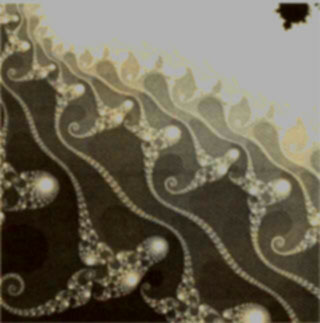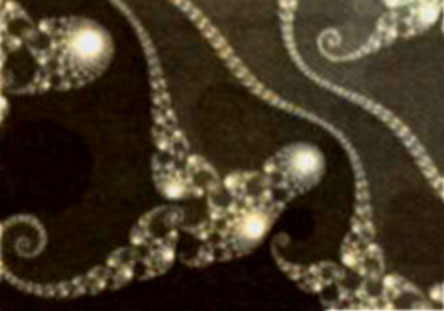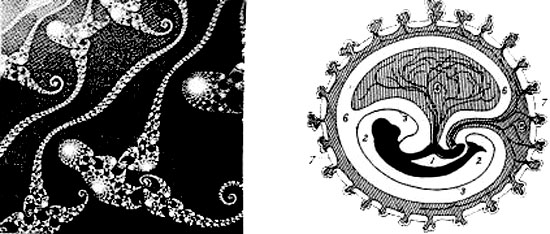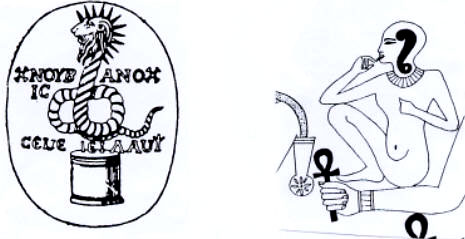|
November 2004 from MetaHistory Website
Non-Ordinary Reason
Aristotle observed that the mark of a
mature mind is to entertain an idea without accepting it - without
"buying" it , as we say today. I am not insisting that anyone buy
the Archon theory of Gnosticism. I propose that we examine
and sample it, that's all. Equanimity is essential when it comes to
the enigma of the Archons.
The man's response is entirely rational within the context of his imagination. When Trekkies (devotees of the cult TV series, Star Trek) avidly discuss characters and events in the series, they are using non-ordinary reason. The Pokeman card-trading phenomena triggered an explosion of non-ordinary reason in which children had to recite in rigorous detail the behaviors and traits specific to over a hundred different entities.
In Internet MMORPGs (Massive
Multiplayer Online Role-Playing Games) players assume fictional
identities that must behave in consistent way, exhibiting a kind of
virtual rationality. The reasoning involved in such role-playing is
rigorous, for players cannot cause their "avatars" to do anything
they like. The avatars must have specific codes of behavior.
Developing and maintaining such codes involves non-ordinary reason.
Far from it.
If the Gnostics were right, it is
primarily by detecting how the Archons work that we can know our own
minds work, and claim the sovereign power of intelligence endowed in
us by Sophia.
In fact, they are called Archons (from the Greek archai, "primordial, first, antecedent in time") because they arise in the planetary system before Earth was formed into a habitat for life.
Sophia's unilateral Dreaming produced a power surge from the cosmic center, and the Goddess, shooting forth like a torrential current, impacted the inert fields of primordial matter in an unusual way.
Gnostic texts use the term "aborted fetus" to describe the results of this impact..
To the Coco de Mer icon we can now add a graphic variation to suggest how the Archons emerge from Sophia's Dreaming, like a leak from a placenta. As explained in the preceding essay of this trilogy, the Coco de Mer with cosmic detailing represents the "trimorphic protennoia," the original three-body world of Sophia's Dreaming.
Our world, the terrestrial biosphere coupled with the sun and the moon, is the manifestation of this Dreaming.
With the arising of the Archons, another Dreaming comes into play outside our threefold world order. I propose to call this the Alien Dreaming. (This choice of language will become self-evident as we proceed.)
This other Dreaming is a spin-off of Sophia's power of emanation, an exotic spill, yet it does not impede or arrest Her original Dreaming.
The Gaia Mythos describes how the impact of the Aeon Sophia upon the density of atomic matter produced a massive fracture, like the shatter pattern on an ice pond.
The pattern has a center where Sophia is located (identified by the Mandelbrot Set), and a spider-web extension of fracture lines that run in all directions (the frozen sea of fractal waves).
Episode 9 describes how Sophia, situated in the center of the impact zone, sees around Her something like a sea of tensile waves, and riding the waves, or actually composing the waves they appear to ride, are self-repeating forms that resemble seahorses. These seahorses are similar to the forms that appear at high reiteration of the equation for the Mandelbrot Set.
These forms correspond to the anatomical type spontaneously
generated from formless atomic matter by Sophia's impact, a type
called the "shadow body," haibes in Coptic.
However, the forms so produced do
resemble the famous "paisley" seen by many people who took LSD in
the 1960s. I would argue, first, that fractals are consistently seen
in altered states, and second, that the patterns thus seen may also
represent real, though supernatural processes in the cosmos at
large.
In the second stage of the unfoldment described in Trimorphic Protennoia, the Aeon Sophia,
Thus the tensile forms morph from semi-rigid seahorses into rounded fetal forms with tails, but the tails, it seems, keep falling off and turning into other embryos.
By
this bizarre process of self-repeating generation, the neonate horde
of the Archons emerges.
In the passage cited here, I apply some concepts drawn from modern astronomy to develop a more vivid picture of events presumably observed by Gnostic seers in the cosmos at large:
A close reading reveals a crucial detail: after the initial formation of the embryonic Archon types, a second variant of "shadow body" arises, with distinct characteristics of its own.
The Hypostasis of the Archons describes it as "an arrogant beast resembling a lion," but this creature is also described (in another cosmological text, the Apocryphon of John 10: 5) as "a serpentine body (drakon) with a lion-like face."
Thus there are two distinct types of Archons:
In The Hypostasis of the Archons (93: 30 - 94:5), a supplicant asks the great angel Eleleth,
Due to the two distinct stages of their generation, the Archons are invested with an aggressive and divisive nature, fighting among their own ranks.
The problem is provisionally resolved, however, when the reptilian type assumes dominance over the massive horde of neonates, and, indeed, over the entire realm of the dema affected by Sophia's plunge:
While the neonate Archons are inert, their forms arrested at a premature stage of development, the reptilian leader is aggressive, territorial, and charged with demonic powers.
For one thing, he is a formidable shapeshifter:
The declaration of the chief Archon that he is the only god in the cosmos is, needless to say, a defining moment in Gnostic cosmology - if not in human evolution as well.
All the cosmological texts describe this event, with slight variations. Gnostics were insistent on the identification of Yaldabaoth with Yahweh or Jehovah, the tribal god of the Hebrews.
This deity is not only blind, but witless and insane (Hypostasis of the Archons 89: 24-25).
To Gnostics insanity is not so much unsoundness of mind as the consequence of failure to correct mental errors. The mentality of the Archons "cannot be rectified," and, what's worse,
Due to the manner of their generation, Archons have no ennoia, no innate intentionality.
Theirs is an Alien Dreaming, set apart
from the biosphere, the intelligent life-field of Gaia.
It also says of the chief Archon that,
This is a telling detail.
The fact that the chief Archon moves away from the
places where he arose indicates a key concern of Gnostics: the
boundary-violating tendencies of the Archons. From the outset they
are an invasive species.
He is called Samael and Saklas. Samael is Hebrew and Saklas is Aramaic for "blind one."
Understanding the blindness of the
Archons is crucially important to our detection of how they can
affect humanity.
Scholars disagree on what this name might mean, and how it was derived. By one translation it means "the child who crosses space." By another, it means "chief of the horde." (Jarl Egil Fossum, The Name of God and the Angel of the Lord, p. 332-6.)
Thus it seems to slur together allusions to both types of Archons. In the Old Testament the title yhwh seba'ot, Yahweh Sebaoth, occurs 276 times as the title of the father god. (Dictionary of Deities and Demons in the Bible, p. 155)
Gershom Scholem, pre-eminent scholar of the Cabala and Jewish mysticism, explained Ialdabaoth as,
And there are half a dozen more
interpretations.
Their uncompromising and sometimes scornful attitude, combined with their failure to anticipate the high degree of physical violence that would be triggered by their challenge to Judeo-Christian beliefs, undoubtedly fuelled the vicious fanaticism that destroyed the Mysteries.
Magnification of the fractal Archon generation presents a graphic image that seems to fit the scenario described by Gnostic seers.
The embryonic type, or neonate Archon, is clearly defined, but so is another entity:
Something odd is happening in the lower part of the neonate's body, for its seahorse-tail is precariously jointed to the torso.
The embryonic type remains self-absorbed, but reacts to the aggression of the other type by dropping its tail, as frightened reptiles do. We wonder if the disjointed tail will form another neonate, or another reptilian.
The reptilian form does appear to be fractally
repeated in the tail-structure of the embryonic type, as if the tail
broke off and became an entity of its own, rather than another
embryo.
The possibility that human fear is a kind of nutriment for certain invasive extraterrestrials has been widely argued in the ET/UFO debate. The Second Treatise of the Great Seth says that the agenda of the Archons is "fear and slavery."
The Archons wish to keep humankind under,
Other passages also warn against the Archons' use of fear as a
psychological weapon.
Gnostics had their own version of what
transpired in the Garden of Eden, events in which the Archons were
deeply involved, and so it is perhaps not surprizing to see hints of
the Paradise scenario at this primal stage of cosmic activity.
It takes non-ordinary reason to describe
what is happening here, but the scenario so developed is entirely
reasonable and coherent on its own terms.
And they do more as well, for the fractal embryos and reptilians also mimic features of human gestation (or vice versa). In human conception, the embryonic sac consists of two parts: the yolk sac (4 in the illustration below), and the foetal mass attached to it (1), suspended in amniotic fluid (2).
At the moment the developing embryo gains initial anatomical definition, it is fish-like (a fact that medical science likes to use to remind us of our pre-human origins). It has a distinct head, and a tail, and a third feature, the umbilicus that connects it to the yolk sac through which it is fed.
The fractal generation of the Archons exhibits all these features in a clear and precise manner.
As the embryo grows, the yolk sac (4 in above image) contracts, and there is at the same time a secondary development.
Also connected to the umbilicus is the allontois (5), a vesicle that fills the interspace between the amnion (3) and the chorion (7), the outermost boundary of the entire placental sac. A kind of morphological tension plays between these evolving structures: for the allontois to grow, it must contract or press back (repress) the yolk sac that feeds the growing fetus.
Unless the allontois grows in this manner, the protective placenta cannot be fully matured. A similar tension pertains between the embryonic Archons and the reptilians. Just as embryonic development in humans is divided between the growth of the fetus fed from the yolk sac, and the repression of the yolk sac to produce the full-grown placenta from the allontois membrane, the power of the Archons is divided by the nature of their generation ("because of their manner of being," cited above)
This conflict is partially resolved when
the reptilian type assumes dominance over the massive horde of
neonates.
Their choice of this bizarre metaphor
must have been intentional, reflecting the occult perception that
Archon anatomy mimics the neonate form of humans. Such a metaphor is
extremely valuable, not only because it allows us to visualize what
Gnostic seers detected by extrasensory perception, but also because
it establishes a close tie between the human species on earth and
the pre-terrestrial Archons.
For Gnostics the lion represented the blind force of procreation (an association that probably stems from Egyptian Mystery schools, not to mention observation of the force and noise of lions mating in the desert), so the sperm-like body of the lion-headed reptilians is even more appropriate.
This drakonic type of Archon appears on Gnostic germs, not because the Gnostics worshipped the reptilians - far from it - but because they viewed the image as a magical antidote to Archontic influence.
Rather in the way a skull on a label indicates a poisonous liquid, thus preventing us from mistaking it for a liquid that is safe to drink, the lion-serpent image was represented on Gnostic amulets to ward off Archontic intrusion.
The lion-headed serpent of the Gnostics is called by magical names such as Ophis, Knuphis, and Abrasax.
In the occult anatomy of Asian mysticism and Yoga, this reptile is known as Kundalini, the serpent power. Gnostics who practiced Kundalini yoga were called Ophites, from the Greek ophis, "snake." This cult was condemned by early Christians as pagan "snake-worshippers."
To the mundane and uninitiated mind, the Kundalini serpent can only be conceived by crude literalization.
To
Gnostics, the lion-headed serpent crowned with solar rays was not
only the image of the Lord Archon, but also of the source of
spiritual power that allows human beings to resist that entity.
In The Inner Reaches of Outer Space, Campbell shows how the image of Kundalini, the "serpent power," appears in world art from the Indus Valley circa 2300 BCE and continues right across the spectrum of ancient cultures, well down into the Common Era.
As late at the 16th century, golden thalers in Germany (Campbell, Fig. 8) showed the Crucifixion on one face and a serpent draped over the cross on the other.
At that late date, Christ would have been identified with Kundalini - without an inkling of why, however - but to Gnostics the snake on the cross was a cancellation of the saving power attributed to crucifixion (i.e., the glorification of suffering as a redemptive force).
Arousal of Kundalini produces
ecstacy, triggers superconsciousness, opens the occult faculties,
and releases waves of healing energy that flush physiological and
hormonal secretions through the body.
In a complete reversal of the usual reading of the Fall, Gnostics regarded the serpent as a spiritual ally to primal humanity,
The "unknowing god" who falsely
identified himself with the Absolute is of course Yaldabaoth, alias
Jehovah.
In his monograph on the Archons, I. S. Gilhus notes that,
Pneumatics is the Gnostic terms for humans who pursue the path of psychosomatic illumination, the key method of Gnostic religion. Pneuma, "spiritual force," is developed by cultvation of nous, "higher intelligence."
But the Archons present a blind field of resistance to this process:
in short, they rely on humans remaining ignorant of their inherent
spiritual potential.
The Dialogue of the Savior, NHC III, 5 (85), contains this exchange:
The savior-teacher is emphatic that we have power over the Archons, but he also makes it clear that some human failings impede the use of our power.
The Greek word phthonos may be translated as "jealousy" or "envy." Gnostics considered envy to be the signature of the Archons, as well as the key human failing that makes us vulnerable to their intrusion.
"The protection of the Light" comes through activated Kundalini, often described as a lightning-like tide of electrified light that pours through the body. "Nymphion" is a code word for the ambient cell of psychophysical protection generated by high levels of Kundalini.
Buddhist scholars such as E. A. Evans-Wentz,
J. M. Reynolds, and H.
V. Guenther have made similar observations, but Gnostic scholars
have not reciprocated because they do not look outside their genre
to understand the theory and practice of Gnosis.
Did Egyptian priests who directed the breeding of the dynastic families have intimate knowledge of Kundalini, as well as the Archons?
The Kundalini serpent is displayed in Egyptian sacred art by a standing cobra, or a pair of cobras, sometimes wound on a staff, and by the uraeus, the cobra headress of divine empowerment. The ceremonial braid on the side of Horus' head was yet another indication of the serpent power.
The pharaonic
braid, traditionally worn on the right side of the head, visually
repeats the form of the spermatic cobras of Edfu. The sacred
iconography carries explicit, but highly occult knowledge: Horus is
the child who right-brain cerebral functions are heightened by the
serpent power.
We shall see that the complex biological symbolism
of Gnostic myth has much to teach us about the nature of the
Archons, as well as how we can resist them.
Gnostics, to whom ethics must be consistent with cosmology, regarded biological procreation, insofar as it is an involuntary act, as a mindless mechanism that makes humans accessory to the head Archon.
How Ialdabaoth breeds his own type, and controls the breeding of the embryo-types, and may even be involved in interbreeding with humans - are some of the more baffling elements in the Sophia mythos.
Several texts in the NHC describe the Archons' attempt to "rape Eve": i.e., inseminate the human species. The texts make it clear, however, that they do not succeed in their aims.
The Hypostasis of the Archons describes this episode:
This passage demonstrates the imaginal sophistication of Gnostic vision.
Gnostics seers discerned the Archons attempt to inseminate Eve - to interfere in the genetics of the human species, if you will - but they also observed that the attempt was a failure. The metamorphosis of Eve into a tree recalls the Greek myth of Daphne who turned into a laurel.
(This parallel shows that Gnostic cosmo-mythology was not a fluke, but a system of visionary knowledge deeply rooted in the indigenous mind of pre-Christian Europe.)
For Gnostics, the visions they beheld in altered states were empirically true and could be tested. By doing so, they were able to develop extraordinary insight into the superhuman worlds, the activities of the gods, the relation of humanity to alien species, and the long-term experience of the human species.
They may distort
our sense of our own genetic make-up.
For instance, by imposing on women an artificial notion of identity, a falsification of their true nature? If so, we would be regarded by Gnostics as accessory to the rape of Eve by the Archons.
Is there evidence in the world today that we have a distorted view of genetics?
If so, this distortion, and the actions
that proceed from it, would fully merit being regarded as
consequences of the Archons' deviating effect on human behavior.
Most theories of the ET breeding program assume that whatever the aliens (usually, the embryonic Grey types are suspect) might choose to do, they can do. But Gnostic seers who applied non-ordinary reasoning to their observations of the Archons reached a different conclusion.
In the Gnostic view, it would be a huge error to assume the Archons are doing things they cannot do, for that would give them power over us. Gnostics taught that the main danger we face with the Archons lies less in what they can actually do than in what we falsely believe they can do.
Their trump card is deceit (apaton and plane in Greek), especially deceit about the nature and extent of their powers.
Strange as they are, certain elements in the Gnostic mythos of our species may now begin to look familiar.
The theme of alien insemination of the human race also occurs in archaic narratives from ancient Sumeria, dating to the third millennium BCE, and it is rampant in contemporary ET/UFO lore. Sumerian accounts describe an alien species called the Anunnaki, who are credited with producing the human species by genetic engineering, and also with inaugurating civilization.
These narratives are found on cuneiform tablets dating to circa 1800 BCE, but they preserve late redactions of much earlier versions.
Apparently, the story about alien
intervention is one of the oldest scripts of our species. Many
people who follow the ET/UFO debate are aware of the Sumerian
accounts of the Anunnaki, who are easily equated with modern-day ETs,
but there is a total absence of reference to the Gnostic scenario of
the Archons in the controversy so far.
This point is extremely difficult to clarify, however...
By far the most striking difference between the
Sumerian and Gnostic accounts is that the former contain no inkling
of the Sophia mythos and no explanation of how the Archons, alias
Anunnaki, originated. This is a considerable lacuna, to say the
least.
In Sitchin's version of prehistory, the Anunnaki came to earth in quest of gold for manufacturing a colloidal suspension needed to stabilize their atmosphere. (For a full account, see Sitchin's last book, The Lost Book of Enki.)
Although Sitchin appears to be a legitimate Sumerologist with a profound grasp of ancient languages, no orthodox scholar endorses his scenario for the Anunnaki. At worst, it is dismissed as an "ancient astronauts" fantasy dressed up in scholarly robes.
I am unable to say whether Sitchin's account of the Anunnaki on Nibiru is an accurate rendition of cunieform texts or a fantasy extrapolated in his mind. Significantly, Sitchin never describes the physical appearance of the Anunnaki of either type.
One of the great benefits of the Gnostic Archon scenario is that it does provide vivid descriptions of these entities.
The same manifestations that
created our religious beliefs,
A serious look at the
Phenomenon
of
looking at
religion. UFO: Operation Trojan Horse
It is startling to find vivid and detailed descriptions of predatory aliens in obscure texts dating from the 4th century CE, but the revelations of Gnosis are nothing if not startling.
Some ancient reports of "UFO sightings" do exist, but Gnostic material on the Archons does not merely present "reports."
It explains their origins in the cosmic
order, their nature (inorganic, imitative, without intentionality),
their appearance and tactics, their attitude toward humanity, and
more. A more clear and coherent solution to "the Phenomenon" (the
ET/UFO enigma) could hardly be imagined.
We are faced with the choice of
believing that these texts represent an accurate account of what
Gnostic seers observed in states of non-ordinary reality - that is,
a reliable report of genuine parapsychological research achieved by
remote viewing,
lucid dreaming,
clairvoyant observation, and then
carefully assessed by non-ordinary reason - or believing that
Gnostics were mere fantasists, mystics deluded by their visions,
wacko cult weirdoes, or worse.
To apply these ideas to the problem of the Archons, let's recall that we, the human species, are involved in a special way in Gaia's Dreaming, which originates from the trimorphic protennoia, the threefold primal intention of the Aeon Sophia.
Our proper boundaries are defined by the earth-moon-sun trinity, and our wisdom endowment unfolds, given by Sophia, unfolds within the unique conditions of the biosphere, the womb of Gaia.
However, there is another Dreaming
that leaks into the Earth Dreaming, rather like a wireless message
that bleeds through into a conversation in progress on another
frequency.
The magical journey of awareness in which we co-evolve with Gaia's Dreaming is deviated or distorted by an alien influence, so the Gnostics taught. On this recondite point they seem to have agreed with the old Yaqui sorcerer, Don Juan, who said to Carlos Castañeda,
In the companion essay,
How We Are Deviated, we will look more
closely at how Gnostics described the intrusion of these extraneous
forces, the alien entities who are also our cosmic cousins.
|





